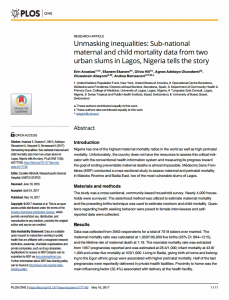
Introduction
Nigeria has one of the highest maternal mortality ratios in the world as well as high perinatal mortality. Unfortunately, the country does not have the resources to assess this critical indicator with the conventional health information system and measuring its progress toward the goal of ending preventable maternal deaths is almost impossible. Me´decins Sans Frontières (MSF) conducted a cross-sectional study to assess maternal and perinatal mortality in Makoko Riverine and Badia East, two of the most vulnerable slums of Lagos.
Materials and methods
The study was a cross-sectional, community-based household survey. Nearly 4,000 households were surveyed. The sisterhood method was utilized to estimate maternal mortality and the preceding births technique was used to estimate newborn and child mortality. Questions regarding health seeking behavior were posed to female interviewees and selfreported data were collected.
Results
Data was collected from 3963 respondents for a total of 7018 sisters ever married. The maternal mortality ratio was calculated at 1,050/100,000 live births (95% CI: 894–1215), and the lifetime risk of maternal death at 1:18. The neonatal mortality rate was extracted from 1967 pregnancies reported and was estimated at 28.4/1,000; infant mortality at 43.8/ 1,000 and under-five mortality at 103/1,000. Living in Badia, giving birth at home and belonging to the Egun ethnic group were associated with higher perinatal mortality. Half of the last pregnancies were reportedly delivered in private health facilities. Proximity to home was the main influencing factor (32.4%) associated with delivery at the health facility